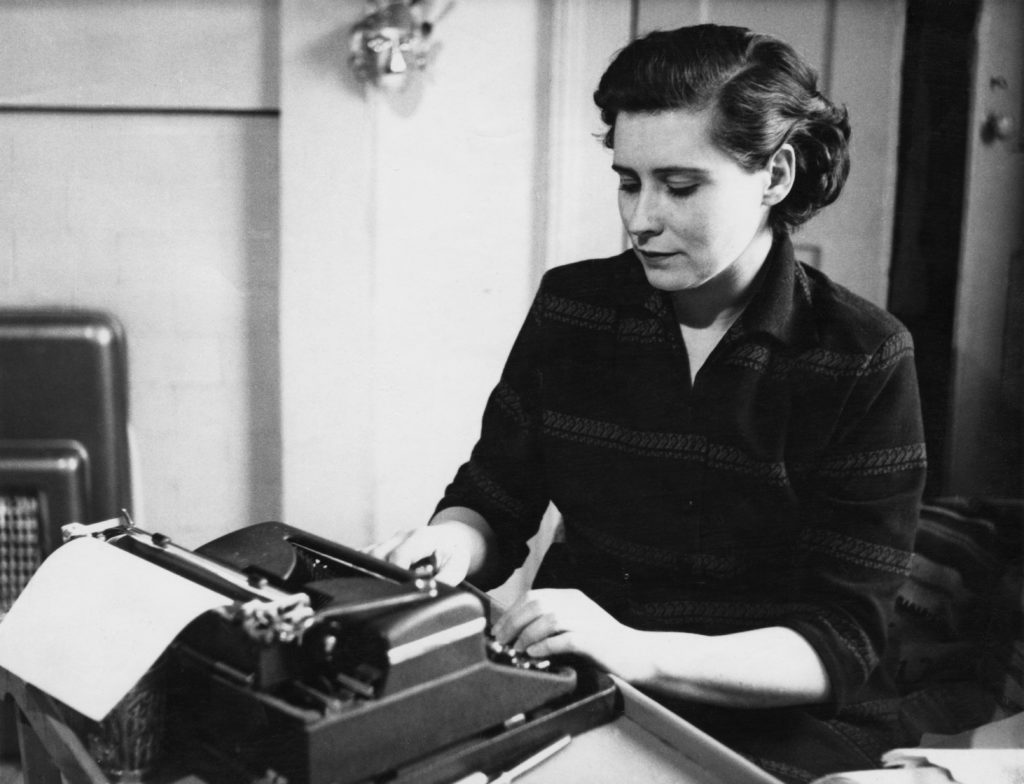Just after 10.30 on the morning of 22nd April 1953, a Scotland Yard agent sat listening in on the static of the telephone exchange, a typewriter expectantly in front of him. His job was to monitor the tapped phones of suspected foreign agents, who posed a potential danger to the security of the British Empire. Suddenly, there was a click, and a voice crackled onto the line – a woman’s voice, clear, cool and confident. The agent began to type.
Doris Lessing at 100
Ahead of The Doris Lessing 100 Exhibition, we look at how the writer became a London literary star

Doris Lessing at her typewriter, c.1950. © Paul Popper, photographer
“Doris Lessing rang Emil Burns,” he wrote. “She said that the previous day she had a terrific problem with a novel.”
This little snippet of conversation, nearly seventy years old and stamped TOP SECRET, has survived because the Nobel-Prize-winning author Doris Lessing was once considered a danger to the United Kingdom.
Wild child
Born in Persia in 1919, Doris Lessing grew up in the rugged bush of Zimbabwe, then the British Crown colony of Southern Rhodesia. From the earliest age, Lessing rebelled against the strict Edwardian standards of her parents. She was a wild child, always off exploring the bush with her brother – and this wildness continued into adulthood. Stifled by her first marriage, she was swept up in a whirlwind of anti-Imperial political activism, marrying the leader of a local Communist group, Gottfried Lessing, and involved in love affairs with British airmen.
When Lessing arrived in London in 1949, Britain’s spy community were aware. The South African Police had informed MI5, calling her “an attractive, dangerous and forceful woman”. The British secret service began monitoring her activities, following her, tapping her phones and even searching her bags when she passed through Heathrow. “A discreet search of her baggage by H.M. Customs revealed nothing of interest to Special Branch,” one 1954 report states.
An author of 'considerable stature'
In London Lessing burst onto the literary scene, with her first novel, The Grass is Singing, which portrayed the stifling culture of colonial Rhodesia. After this success, more novels followed in an outburst of creativity, most famously The Golden Notebook in 1962. One MI5 report from that year remarks with apparent dismay: “She is now viewed as an author of considerable stature.”
Lessing had numerous affairs, perhaps most famously with the American writer Clancy Sigal. Their tumultuous relationship was later portrayed through the character of Saul in The Golden Notebook.
Vast curiosity
Lessing’s relationship with communism would sour. After witnessing the brutality of the Hungarian Uprising, and the Soviet Invasion of Afghanistan, Lessing turned against the Soviet project and became one of its most vocal critics. She was a person of vast intellectual curiosity, and through the course of her life, her interests ranged wildly through Eastern spiritualism and folktales, feminism and literature, psychology and the exploration of space, the effects of nuclear war and the possibility of the end of the world.
The Doris Lessing 100 Exhibition brings together many facets of her amazing life, and shows Doris Lessing as you have never seen her before. Lessing’s newly-declassified surveillance files and private letters and journals will be displayed in public for the first time, showing her remarkable journey through communism, her fascination with the study of Sufi mysticism, her meditation practices and visions, her research into how the world might end, and her dreams of one day travelling beyond the stars. This is the unseen life of a literary icon, coming to the Sainsbury Centre this September.